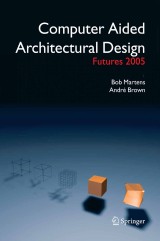Details

Computer Aided Architectural Design Futures 2005
Proceedings of the 11th International CAAD Futures Conference held at the Vienna University of Technology, Vienna, Austria, on June 20-22, 2005|
213,99 € |
|
| Verlag: | Springer |
| Format: | |
| Veröffentl.: | 06.12.2005 |
| ISBN/EAN: | 9781402036989 |
| Sprache: | englisch |
| Anzahl Seiten: | 481 |
Dieses eBook enthält ein Wasserzeichen.
Beschreibungen
MARTENS Bob and BROWN Andre Co-conference Chairs, CAAD Futures 2005 Computer Aided Architectural Design is a particularly dynamic field that is developing through the actions of architects, software developers, researchers, technologists, users, and society alike. CAAD tools in the architectural office are no longer prominent outsiders, but have become ubiquitous tools for all professionals in the design disciplines. At the same time, techniques and tools from other fields and uses, are entering the field of architectural design. This is exemplified by the tendency to speak of Information and Communication Technology as a field in which CAAD is embedded. Exciting new combinations are possible for those, who are firmly grounded in an understanding of architectural design and who have a clear vision of the potential use of ICT. CAAD Futures 2005 called for innovative and original papers in the field of Computer Aided Architectural Design, that present rigorous, high-quality research and development work. Papers should point towards the future, but be based on a thorough understanding of the past and present.
Keynote Papers.- Digitally Sponsored Convergence of Design Education, Research and Practice.- Space, Time, Mind.- Constructing Complexity.- Virtual Heritage, Reconstruction and Histories.- Labyrinthine Digital Histories.- A 3D Model of the Inner City of Beijing.- A Method Proposed for Adoption of Digital Technology in Architectural Heritage Documentation.- From Architectural Intent to Physical Model.- Interactive Visualization of Large-Scale Architectural Models over the Grid.- Digital Design, Representation and Visualization.- Townscaping: Development of Dynamic Virtual City Augmented 3D Sketch Design Tools.- Towards a Virtual Reality Tool for Lighting.- A Visual Landscape Assessment Approach for High-density Urban Development.- Architectural Cinematographer: An Initial Approach to Experiential Design in Virtual Worlds.- Virtual Environments in Design and Evaluation.- Do We Need CAD during Conceptual Design?.- Contemporary Digital Techniques in the Early Stages of Design.- Optimizing Architectural Layout Design via Mixed Integer Programming.- Design Methods, Process and Creativity.- Examining Learning in Multiple Settings.- Using Historical Know-how to Model Design References.- Semantic Roomobjects for Conceptual Design Support.- Shared Design Space.- Knowledge Based Design and Generative Systems.- Generation of Apparently Irregular Truss Structures.- Dynamic Designs of 3D Virtual Worlds Using Generative Design Agents.- Using Cellular Automata to Generate High-Density Building Form.- Dynamic Generative Modelling System for Urban and Regional Design.- Turning the Design Process Downside-up.- Human-machine Interaction: Connecting the Physical and the Virtual.- iSphere.- Learning Design with Digital Sketching.- Simulating Human Behaviour in Built Environments.- Resolvingsome Ambiguities in Real-time Design Drawing Recognition by means of a Decision Tree for Agents.- Sketching with Digital Pen and Paper.- Mindstage: Towards a Functional Virtual Architecture.- Advanced Ubiquitous Media for Interactive Space.- Hands Free.- Responsive Sensate Environments: Past and Future Directions.- Form and Fabric: Computer Integrated Construction and Manufacturing.- The Redefinition of Ornament.- Wood Frame Grammar.- Transformations on Parametric Design Models.- Building Information Modelling and Construction Management.- Spatial Reasoning for Building Model Reconstruction Based on Sensed Object Location Information.- Construction Analysis during the Design Process.- A Software Architecture for Self-updating Life-cycle Building Models.- Multidisciplinary Design in Virtual Worlds.- Linking Education, Research and Practice.- A Multi-Disciplinary Design Studio using a Shared IFC Building Model.- Case Studies of Web-Based Collaborative Design.- Interdisciplinary Knowledge Modelling for Free-Form Design — An Educational Experiment.
The official conference proceedings of CAAD Futures 2005
Diese Produkte könnten Sie auch interessieren:

Decision Support Systems for Risk-Based Management of Contaminated Sites

von: Antonio Marcomini, Glenn Walter Suter II, Andrea Critto

96,29 €

Dynamics of Mercury Pollution on Regional and Global Scales

von: Nicola Pirrone, Kathryn R. Mahaffey

149,79 €














